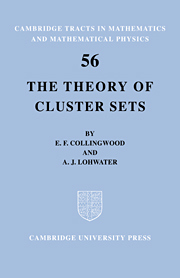Book contents
- Frontmatter
- Contents
- Preface
- Chapter 1 INTRODUCTION
- Chapter 2 FUNCTIONS ANALYTIC IN A CIRCULAR DISC
- Chapter 3 TOPICS IN THE THEORY OF CONFORMAL MAPPING
- Chapter 4 INTRINSIC PROPERTIES OF CLUSTER SETS
- Chapter 5 CLUSTER SETS OF FUNCTIONS ANALYTIC IN THE UNIT DISC
- Chapter 6 BOUNDARY THEORY IN THE LARGE
- Chapter 7 BOUNDARY THEORY IN THE SMALL
- Chapter 8 FURTHER BOUNDARY PROPERTIES OF FUNCTIONS MEROMORPHIC IN THE DISC. CLASSIFICATION OF SINGULARITIES
- Chapter 9 PRIME ENDS
- Bibliography
- Index of symbols
- Index
Chapter 1 - INTRODUCTION
Published online by Cambridge University Press: 06 November 2009
- Frontmatter
- Contents
- Preface
- Chapter 1 INTRODUCTION
- Chapter 2 FUNCTIONS ANALYTIC IN A CIRCULAR DISC
- Chapter 3 TOPICS IN THE THEORY OF CONFORMAL MAPPING
- Chapter 4 INTRINSIC PROPERTIES OF CLUSTER SETS
- Chapter 5 CLUSTER SETS OF FUNCTIONS ANALYTIC IN THE UNIT DISC
- Chapter 6 BOUNDARY THEORY IN THE LARGE
- Chapter 7 BOUNDARY THEORY IN THE SMALL
- Chapter 8 FURTHER BOUNDARY PROPERTIES OF FUNCTIONS MEROMORPHIC IN THE DISC. CLASSIFICATION OF SINGULARITIES
- Chapter 9 PRIME ENDS
- Bibliography
- Index of symbols
- Index
Summary
The cluster set. Definition
The notion of a cluster set was first formulated explicitly by Painlevé ([1], p. 438) in his well-known Stockholm lectures of 1895 on differential equations. Painlevé introduced the cluster set, which he called domaine d'indétermination, as a descriptive notion to characterize in an intuitive way the behaviour of an analytic function in the neighbourhood of a singularity in terms of the properties of the set of all its limits at the singularity, and to classify the singularities of a function in terms of these cluster sets.
Although Painlevé was considering only analytic functions, the notion of a cluster set does not depend, any more than does the notion of a limit, upon the function being analytic or even continuous; nor need it be restricted to complex-valued functions of a complex variable. It is equally applicable to real functions of a real variable and to mappings in spaces of higher dimensions, as well as to general topological spaces, although not necessarily equally fruitfully in all cases. We shall therefore introduce the definitions in a sufficiently general form to include the special cases we shall require in later chapters.
Let the function w = f(z) be defined in a domain D which it maps into the w-sphere S. Unless otherwise stated, we shall take D to be in the z-plane, but if D is an open set on the real line, we shall assume the mapping to be into the real line or into a great circle in S.
- Type
- Chapter
- Information
- The Theory of Cluster Sets , pp. 1 - 16Publisher: Cambridge University PressPrint publication year: 1966



